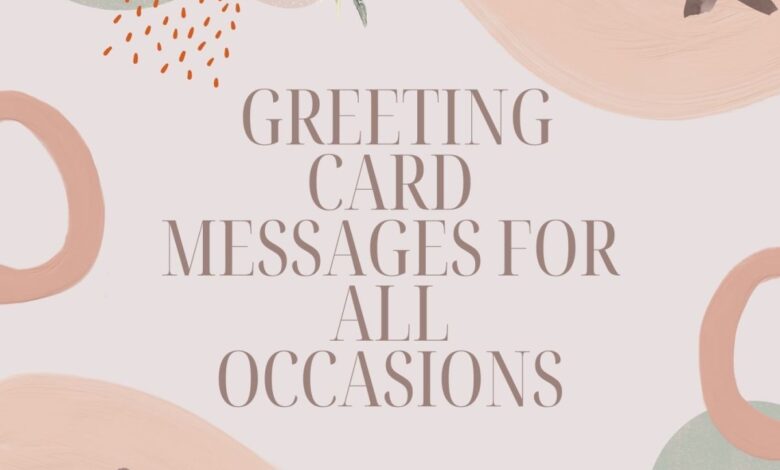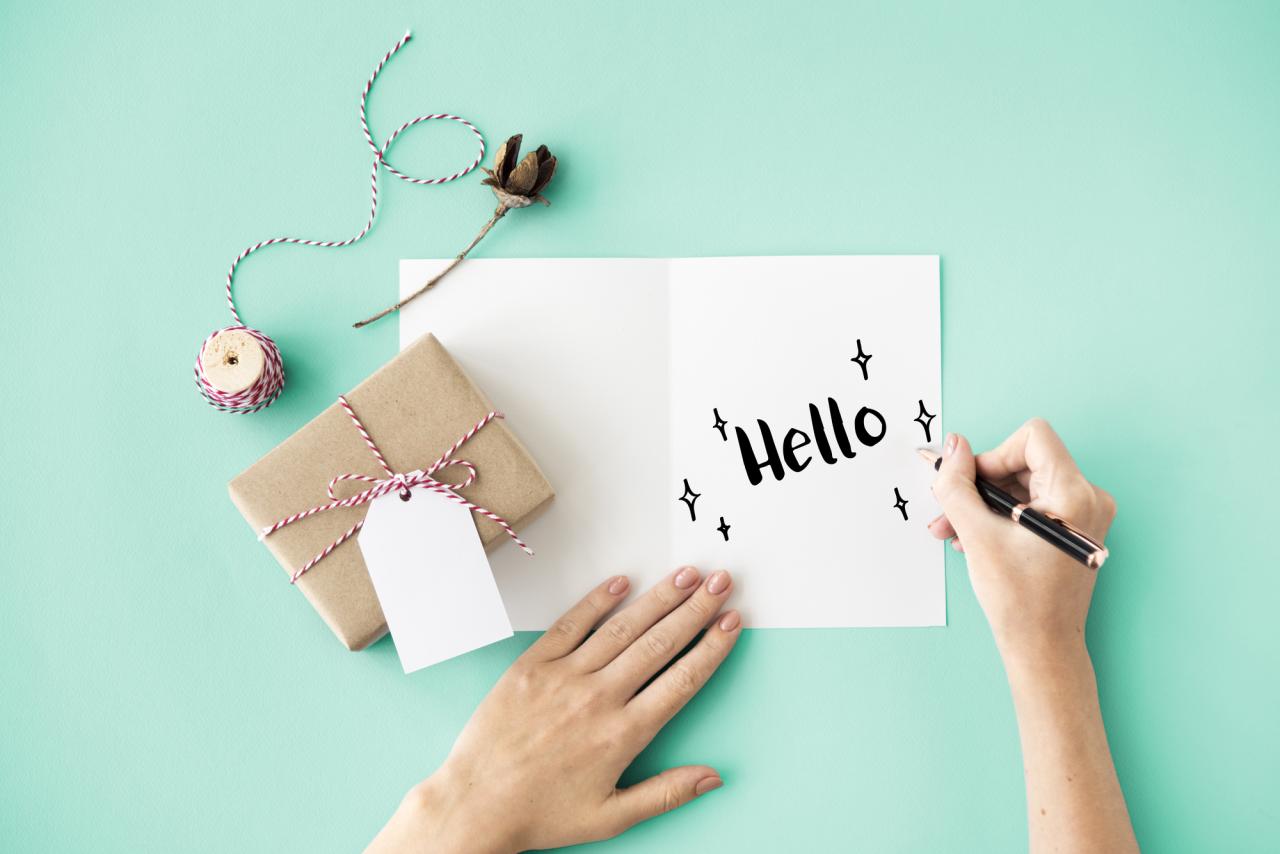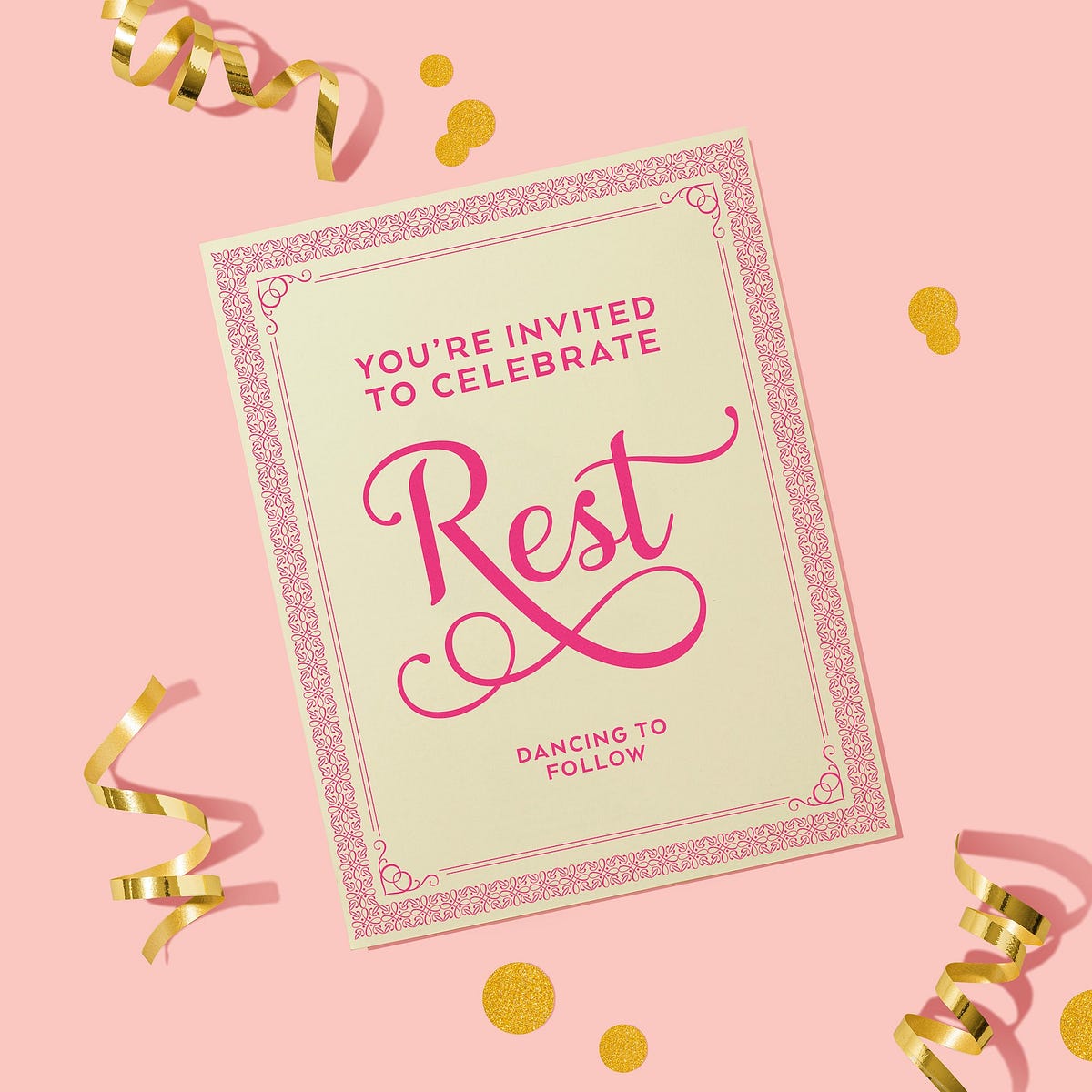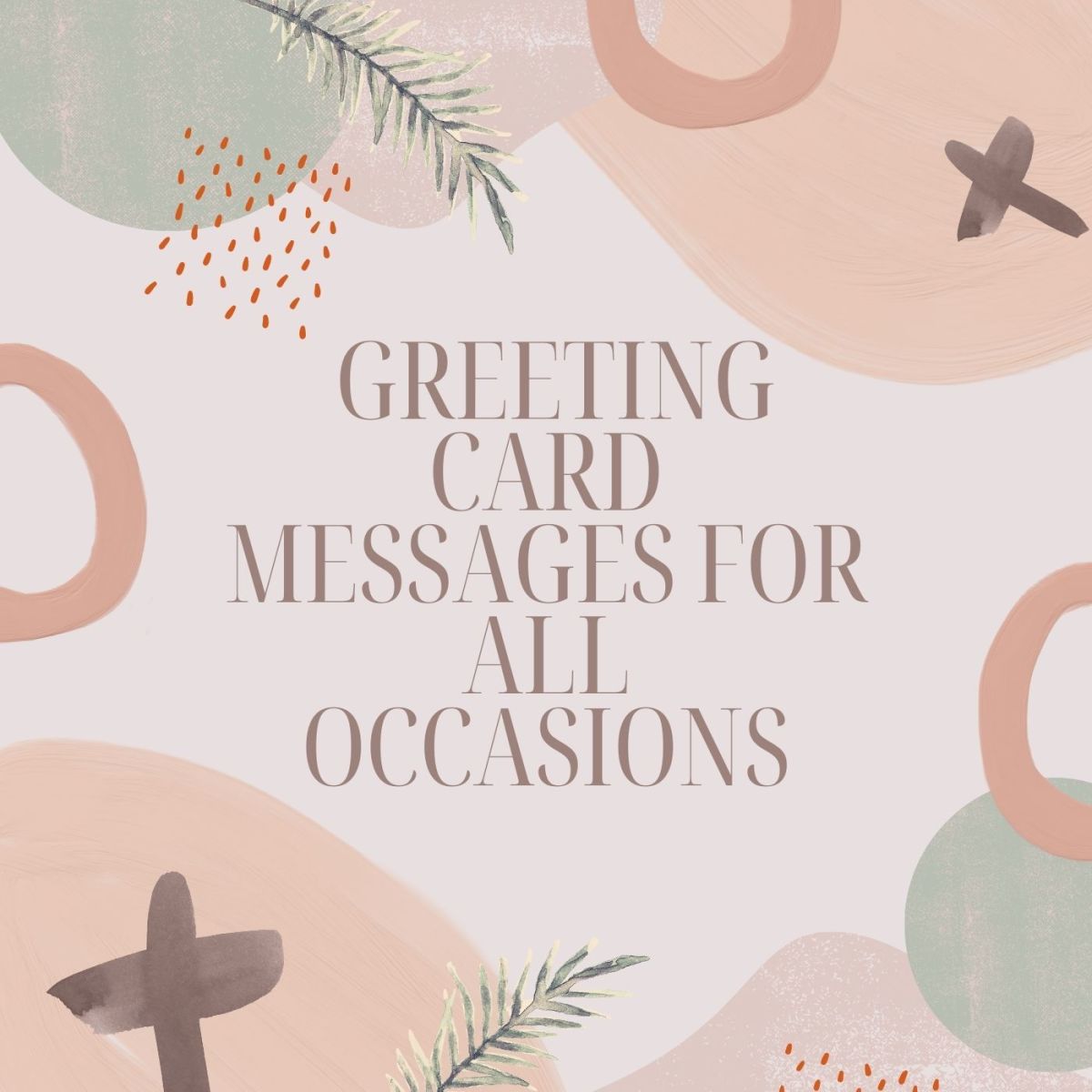
How to Write a Greeting Card
How to write a greeting card? It might seem simple, but crafting the perfect message takes more than just a quick scribble. From understanding your audience and choosing the right occasion to adding those special personal touches, this guide will walk you through the process, ensuring your heartfelt sentiments are beautifully expressed. We’ll explore different writing styles, visual presentations, and even offer tips for proofreading your masterpiece before sending it off to bring joy to someone’s day.
We’ll cover everything from identifying the perfect tone for different relationships (friends, family, colleagues) and occasions (birthdays, weddings, graduations), to structuring your message effectively—whether you prefer an anecdotal approach, a bulleted list, or even a short poem. We’ll also dive into the visual aspects of card design, helping you create a card that’s as visually appealing as it is heartfelt.
Get ready to unleash your inner wordsmith and create greeting cards that truly resonate!
Understanding Your Audience
Crafting the perfect greeting card hinges on understanding who you’re writing for. The tone, style, and even the choice of words can drastically alter the impact of your message. Failing to consider your audience can lead to a card that feels impersonal or even inappropriate. Let’s explore how to tailor your message for different recipients.
Recipient Profiles and Appropriate Greeting Card Styles
Choosing the right style depends heavily on your relationship with the recipient. A card for a close friend will differ significantly from one for a professional colleague. Consider these three distinct profiles:
- Friend: For friends, a casual and playful style works best. Think vibrant colors, quirky illustrations, and a handwritten feel. You can be more informal and expressive, using inside jokes or references to shared experiences. A fun, slightly offbeat design often suits this audience.
- Family Member: Cards for family members often strike a balance between warmth and formality. The style might be more traditional, perhaps with elegant fonts and classic imagery. While the tone can be affectionate and personal, it’s generally more restrained than that used for friends.
- Colleague: Professional colleagues require a formal and respectful approach. The design should be clean and sophisticated, avoiding overly playful or sentimental elements. The language must be appropriate for a workplace setting, focusing on professional achievements or well wishes.
Sample Opening Lines for Different Recipients
The opening line sets the tone for the entire card. A well-chosen opening instantly connects with the recipient and establishes the right level of formality. Here are some examples:
- Friend: “You won’t believe what happened the other day!…” (Establishes a casual and engaging tone)
- Family Member: “Thinking of you and sending lots of love on this special occasion…” (Warm and affectionate)
- Colleague: “Congratulations on your recent promotion! Your hard work and dedication are truly commendable.” (Formal and professional)
Language Formality Across Recipient Profiles
The level of formality in your language directly correlates with your relationship with the recipient.
- Friends: Informal language, contractions, slang, and inside jokes are perfectly acceptable. The tone should be relaxed and conversational, mirroring your spoken interactions.
- Family Members: The language can be more personal and affectionate than with colleagues, but it generally avoids slang and overly casual phrasing. The tone should be warm and heartfelt, but still respectful.
- Colleagues: Formal language is essential. Avoid slang, contractions, and overly personal anecdotes. Maintain a professional and respectful tone throughout the message, focusing on appropriate workplace etiquette.
Choosing the Right Occasion

Source: itsmejd.com
Choosing the perfect greeting card hinges on understanding not just
- who* you’re writing to, but
- why*. The occasion dictates the tone and message, setting the overall mood and impact of your heartfelt words. Selecting the right card is about expressing genuine emotion in a way that resonates with the recipient. A poorly chosen card can feel impersonal, even insensitive, while the right one can strengthen bonds and create lasting memories.
Different occasions call for different approaches. The tone and message should be tailored to the specific event, reflecting the significance of the moment and the relationship you share with the recipient. Consider the level of formality, the emotional weight of the occasion, and the overall message you wish to convey.
Occasion-Specific Greeting Card Messages
Let’s explore five common occasions and how to craft appropriate messages. Each occasion presents a unique opportunity to express your feelings in a meaningful way. The examples provided offer a starting point; feel free to personalize them to reflect your own unique style and relationship with the recipient.
| Occasion | Message | Tone | Recipient |
|---|---|---|---|
| Birthday | Wishing you a day filled with joy, laughter, and all the things that make you happy! | Warm, celebratory | Close friend |
| Birthday | Happy Birthday! Hope your special day is as wonderful as you are. | Friendly, appreciative | Colleague |
| Birthday | To my amazing [Name], wishing you a birthday filled with love, happiness, and unforgettable moments. | Affectionate, heartfelt | Partner |
| Birthday | Happy Birthday, [Name]! Wishing you a year filled with success and happiness. | Formal, professional | Client |
| Birthday | Happy Birthday, sweetie! I love you more than words can say. | Intimate, loving | Grandchild |
| Wedding | Wishing you a lifetime of love, laughter, and happiness together! | Joyful, celebratory | Friends |
| Wedding | Congratulations on your wedding! May your life together be filled with joy and adventure. | Warm, congratulatory | Relatives |
| Wedding | To the happy couple, wishing you a marriage filled with love, understanding, and lasting commitment. | Formal, sincere | Colleagues |
| Wedding | So happy for you both! Wishing you a lifetime of love and happiness. | Enthusiastic, supportive | Close friend |
| Wedding | Wishing you both a lifetime of happiness and love. Congratulations! | Simple, elegant | Acquaintance |
| Graduation | Congratulations on your graduation! So proud of all your hard work and dedication. | Proud, encouraging | Child |
| Graduation | Congratulations on this incredible achievement! Wishing you all the best in your future endeavors. | Formal, congratulatory | Professor |
| Graduation | Way to go! All your hard work has paid off. So excited for what’s next. | Informal, celebratory | Close friend |
| Graduation | Congratulations on graduating! Your future is bright. | Positive, optimistic | Relative |
| Graduation | Congratulations on your graduation! Best wishes for your future career. | Supportive, professional | Mentor |
| Sympathy | Thinking of you during this difficult time. My deepest condolences. | Sincere, compassionate | Friend |
| Sympathy | With heartfelt sympathy on the loss of [Name]. May fond memories bring you comfort. | Formal, respectful | Colleague |
| Sympathy | Our hearts go out to you and your family. May [Name]’s memory be a blessing. | Warm, comforting | Family member |
| Sympathy | Sending love and support during this difficult time. | Simple, supportive | Acquaintance |
| Sympathy | So sorry for your loss. Thinking of you. | Brief, compassionate | Close friend |
| New Baby | Congratulations on your precious little one! Wishing you all the joy of parenthood. | Joyful, celebratory | Friend |
| New Baby | Welcome to the world, little one! Sending you lots of love. | Warm, affectionate | Family |
| New Baby | Congratulations on the arrival of your beautiful baby! | Simple, elegant | Colleague |
| New Baby | So excited to welcome your new baby into the world! | Enthusiastic, happy | Close friend |
| New Baby | Wishing you all the best as you welcome your little one into your lives. | Supportive, heartfelt | Relative |
Crafting Your Message
So you’ve chosen the perfect card and know who you’re writing to – now comes the fun part: crafting the perfect message! This is where your personality and relationship with the recipient truly shine. Don’t stress about finding the “perfect” words; authenticity is key. A heartfelt message, however simple, will always resonate more than a generic, overly formal one.The structure of your message can significantly impact its effectiveness.
Crafting the perfect greeting card involves more than just a few words; it’s about genuine connection. Think about your audience, choose your words carefully, and let your personality shine through. For extra inspiration, check out this awesome guide on getting it on with youtube – it’s surprisingly helpful for understanding how to connect with an audience, which is crucial for crafting a compelling message, whether it’s a YouTube video or a heartfelt greeting card.
Remember, the goal is always to make the recipient feel seen and appreciated.
Experimenting with different approaches can help you find what feels most natural and best conveys your feelings. Let’s explore a few options.
Three Approaches to Structuring Your Message
Choosing the right structure depends on your writing style and your relationship with the recipient. A casual message to a close friend might differ vastly from a more formal message to a distant relative. Consider the tone and level of intimacy you want to convey when deciding on your approach.
- Anecdote-Driven: This approach uses a short, relevant story or memory to personalize your message and create a connection with the recipient. It’s ideal for close friends and family where shared experiences abound.
- List-Based: This method is great for highlighting specific qualities or reasons for your greeting. It’s structured and easy to read, making it suitable for various relationships.
- Poem: While challenging, a short, heartfelt poem can be incredibly impactful, especially for significant occasions or loved ones who appreciate creative expression. Don’t worry about being a professional poet; sincerity counts more than perfect rhyme.
Birthday Message Examples
Here are three examples, one for each approach, all celebrating a birthday:
- Anecdote-Driven: “Remember that time we tried to bake a cake and ended up with a flour explosion in the kitchen? That was hilarious, and it perfectly sums up our friendship – always full of laughter and unexpected adventures! Wishing you a birthday filled with just as much joy and maybe a little less flour!”
- List-Based: “Happy Birthday! I’m so grateful for your: amazing sense of humor, unwavering support, infectious enthusiasm, and kind heart. You make every day brighter. Hope your birthday is as wonderful as you are!”
- Poem: “Another year, another smile,
Another journey, worth the while.
May joy and laughter fill your day,
Happy Birthday, hip hip hooray!”
Incorporating Personal Details and Memories
The most impactful greeting cards are those that feel deeply personal. Weaving in specific memories or details shows the recipient you’ve put thought and effort into your message. Think about shared inside jokes, special moments you’ve experienced together, or qualities you admire about them. For example, if your friend loves hiking, you could mention a favorite trail you’ve hiked together.
If your family member is known for their incredible cooking, you could mention a favorite dish they make. These little touches transform a generic message into a truly meaningful one. Don’t be afraid to be sentimental; it’s often the most appreciated aspect of a greeting card.
Visual Presentation: How To Write A Greeting Card
The visual aspect of your greeting card is just as crucial as the words you write. A well-designed card enhances the message and leaves a lasting impression. The visual style you choose should complement the occasion and the recipient’s personality. Let’s explore some options.
Different visual styles evoke distinct emotions. A minimalist design can convey elegance and sophistication, while a colorful card might express joy and exuberance. A whimsical style can communicate playfulness and lightheartedness. Consider the tone you want to set before deciding on your design.
Minimalist Style
Minimalist greeting cards prioritize simplicity and clean lines. They often feature a limited color palette, perhaps just one or two colors, and a simple, uncluttered layout. The focus is on the typography and a single, impactful image or graphic element. This style is perfect for conveying elegance, sophistication, or a sense of calm.
Example: Imagine a cream-colored card with a single, dark-green sprig of eucalyptus subtly placed in the corner. The greeting, “Happy Birthday,” is written in a clean sans-serif font like Helvetica Neue, in a dark-green color matching the eucalyptus. The font size is relatively large, making it the focal point. The back of the card is left blank, except for a small, discreet logo or your name.
Colorful Style
Colorful greeting cards are vibrant and energetic. They often use a bold color scheme, incorporating multiple bright hues and possibly patterns or textures. The layout might be more playful and less structured than a minimalist design. This style is ideal for celebratory occasions or conveying joy, excitement, or enthusiasm.
Example: Picture a bright pink card with a playful, hand-drawn style illustration of colorful balloons floating against a sunny yellow sky. The text, “Congratulations on your Graduation!”, is written in a fun, rounded script font like Pacifico, in a contrasting navy blue. The layout is slightly asymmetrical, with the balloons playfully overlapping the text. Smaller celebratory confetti-like shapes are scattered across the background.
Whimsical Style
Whimsical greeting cards embrace playful illustrations, quirky fonts, and unexpected design elements. They often feature hand-drawn elements, playful patterns, or collage-like aesthetics. This style is excellent for conveying lightheartedness, fun, or a sense of childlike wonder.
Example: Envision a card featuring a watercolor background of pastel rainbow colors. The text, “Thinking of you,” is written in a playful, slightly wobbly handwritten-style font like KG Second Chances, in a deep teal color. Small, whimsical illustrations of friendly animals (perhaps a bunny and a fox) are scattered around the text, adding to the overall light and airy feeling.
The card uses a variety of textures, creating a visually interesting and engaging experience.
Creating Visual Hierarchy
Visual hierarchy is about guiding the reader’s eye through the card’s design. You achieve this by using size, color, contrast, and placement to emphasize certain elements over others. The greeting should always be the most prominent element, followed by any other important information, such as the sender’s name or a personalized message.
For example, use a larger font size for the main greeting, a slightly smaller size for secondary text (like a personalized message), and a smaller size still for details like the sender’s name. You can also use color contrast to highlight key elements; for instance, a dark text on a light background or vice versa. Placement also plays a crucial role; the main greeting should be positioned centrally or in a visually prominent area.
Adding Personal Touches
Going beyond a heartfelt message, adding personalized elements elevates your greeting card from a simple note to a cherished keepsake. These small details demonstrate extra effort and thoughtfulness, creating a more profound and lasting impact on the recipient. The key is to choose touches that reflect your relationship with the recipient and the occasion itself.
Incorporating Hand-Lettered Flourishes
Hand-lettering adds a unique, artistic touch that’s impossible to replicate digitally. It injects personality and warmth into the card. Instead of just signing your name, consider incorporating hand-lettered elements into the main message itself, or adding a decorative border. For example, you could hand-letter a favorite quote, a short poem relevant to the occasion, or even just a few carefully chosen words to emphasize a particular sentiment.To incorporate hand-lettering, choose a pen or brush pen that complements the card’s style.
Practice your lettering on scrap paper beforehand to ensure neatness and consistency. Then, carefully integrate your lettering into the card design, ensuring it doesn’t overshadow the main message but rather enhances it. The impact of hand-lettered flourishes is a feeling of genuine care and artistry. It transforms the card into a small piece of personalized artwork, showcasing your effort and thoughtfulness beyond the words themselves.
Adding Small, Thematic Drawings
A small, simple drawing related to the recipient’s interests or the occasion can significantly boost the card’s impact. This could be anything from a tiny flower for a birthday card to a whimsical illustration of a shared inside joke. The drawing doesn’t have to be perfect; a childlike sketch often carries more charm than a highly polished drawing.To incorporate a small drawing, lightly sketch your design in pencil first.
Then, use colored pencils, pens, or even watercolor paints to bring it to life. Ensure the drawing is small enough not to overwhelm the card but large enough to be easily noticeable. A well-placed drawing can create a feeling of intimacy and shared understanding. It transforms the card from a generic message into a personalized story, reflecting a deeper connection with the recipient.
Using Meaningful Stickers or Washi Tape, How to write a greeting card
Stickers and washi tape offer a quick and easy way to add personalized flair to a greeting card. Choose stickers or washi tape that reflect the recipient’s personality or the occasion. For instance, for a nature-loving friend, use floral stickers or washi tape with leaf patterns. For a celebratory occasion, use colorful confetti stickers or brightly colored washi tape.To incorporate stickers or washi tape, plan their placement carefully.
Consider how they complement the overall design and message of the card. Avoid overcrowding the card with too many stickers or washi tape. Strategic placement of these elements adds a playful and personalized touch. The impact is a feeling of joy and spontaneity, enhancing the overall cheerfulness and celebratory mood of the card. The recipient will appreciate the thoughtful addition that speaks directly to their interests or the occasion.
Proofreading and Finalization

Source: medium.com
Crafting the perfect greeting card involves more than just choosing the right words; it’s about ensuring your message is flawlessly presented. The final step, proofreading and finalization, is crucial for leaving a lasting positive impression on the recipient. A well-written but poorly presented card can diminish its impact, while a carefully proofread card enhances its sincerity and thoughtfulness.The process of reviewing your greeting card before sending it is vital for catching any errors and refining its overall appeal.
Overlooking even small mistakes can detract from the heartfelt message you’re trying to convey. A quick proofread can transform a potentially awkward or confusing message into a beautifully crafted expression of your feelings.
Proofreading Checklist
Before sending your card, it’s essential to take a moment to thoroughly review your work. This final check ensures your message is clear, concise, and error-free. Here’s a checklist to guide you:
- Grammar and Spelling: Carefully check for any grammatical errors, typos, or misspelled words. Even a single mistake can undermine the professionalism and care you’ve put into the card.
- Clarity and Conciseness: Ensure your message is easy to understand and avoids unnecessary jargon or overly long sentences. Brevity is often key in conveying emotion effectively.
- Tone and Appropriateness: Double-check that the tone of your message aligns with your relationship with the recipient and the occasion. A humorous card might be inappropriate for a somber occasion.
- Visual Appeal: Confirm that the layout, font choice, and overall visual presentation complement your message and are aesthetically pleasing.
- Personalization: Verify that any personal details, such as names or dates, are accurate and correctly spelled.
Revising a Sample Message
Let’s say your initial draft reads: “Happy Birthday! Hope you have a great day filled with fun and lots of presents! Love, [Your Name]”. While this conveys the sentiment, it could be improved.A revised version might be: “Happy Birthday, [Recipient’s Name]! Wishing you a day filled with joy, laughter, and everything you wished for. With love, [Your Name]”.Notice the improvements: The revised version includes the recipient’s name for a more personal touch.
It replaces the somewhat materialistic “lots of presents” with the more heartfelt “everything you wished for.” The phrasing is more elegant and less informal. The use of stronger verbs like “joy” and “laughter” adds emotional depth. This simple revision significantly enhances the impact and sincerity of the message.
Ending Remarks

Source: saymedia-content.com
Creating a thoughtful greeting card is more than just sending a message; it’s a chance to connect with someone on a deeper level. By understanding your audience, choosing the right occasion and tone, and adding personal touches, you can craft a card that’s both memorable and meaningful. Remember to take your time, personalize your message, and let your genuine feelings shine through.
With a little creativity and attention to detail, your next greeting card will be a treasured keepsake for years to come.
Popular Questions
What if I don’t know what to write?
Start by thinking about your relationship with the recipient and the occasion. What are some positive memories you share? What are you grateful for? Even a simple “Thinking of you” can be incredibly meaningful.
How long should my message be?
Length isn’t as important as sincerity. A short, heartfelt message is often better than a long, rambling one. Aim for something genuine and personal.
What if I make a mistake?
Don’t worry! Everyone makes mistakes. If it’s a minor error, you can usually just ignore it. If it’s a major mistake, you might want to start over or try to discreetly correct it.
Can I use emojis in a greeting card?
It depends on your audience and the occasion. Emojis can add a fun, informal touch, but they might not be appropriate for all situations. Use your best judgment.
Where can I find inspiration for my greeting card?
Look to your own memories, inside jokes, and shared experiences. Browse online for quotes or poems that resonate with you. Let your creativity flow!
